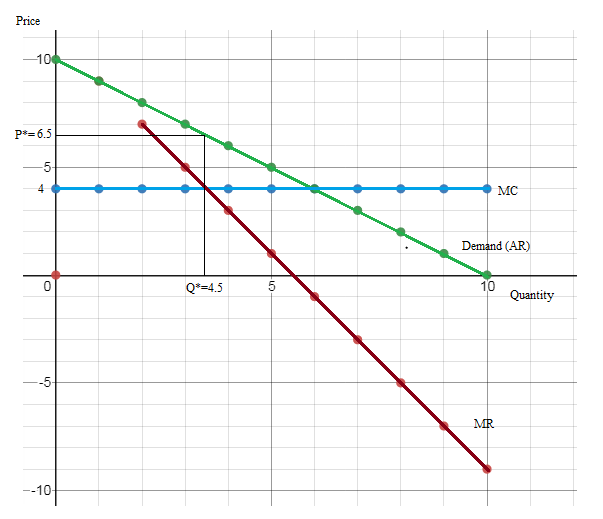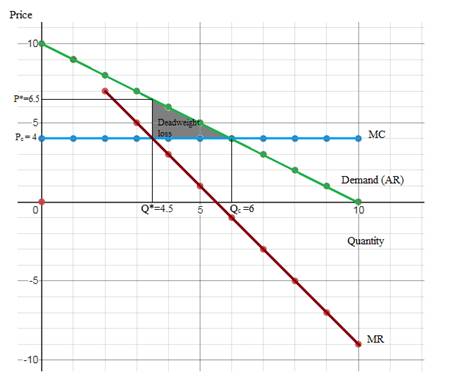
(a)
To compute:
The profit-maximizing quantity and
Answer to Problem 14E
The profit-maximizing quantity and price are Q*=4.5 and P*=$6.5.
Explanation of Solution
The price and quantity schedule is given. The profit-maximizing output for a
The marginal cost is constant at $4 for all levels of output. The total proceeds or income from sale of a given level of output is called total revenue (TR). While the additional revenue generated from sale of an additional level of output is regarded a marginal revenue (MR).
First, calculate TR and MR using the formula below.
| Price (P) | Output (Q) | TR (Total Revenue) | MR (Marginal Revenue) | MC (Marginal Cost) |
| 10 | 0 | 0 | 0 | 4 |
| 9 | 1 | 9 | 9 | 4 |
| 8 | 2 | 16 | 7 | 4 |
| 7 | 3 | 21 | 5 | 4 |
| 6 | 4 | 24 | 3 | 4 |
| 5 | 5 | 25 | 1 | 4 |
| 4 | 6 | 24 | -1 | 4 |
| 3 | 7 | 21 | -3 | 4 |
| 2 | 8 | 16 | -5 | 4 |
| 1 | 9 | 9 | -7 | 4 |
| 0 | 10 | 0 | -9 | 4 |
Using the MR and MC schedules in the table above, draw the graph for MR and MC. The profit-maximizing quantity and price are Q*=4.5 and P*=$6.5.

Monopoly:
Monopoly is a market structure where only one seller exists, and product is differentiated.
The demand for a good is the quantity of that good that consumers are willing and able to purchase at different prices.
Total Revenue (TR):
The total proceeds or income from sale of a given level of output is called total revenue.
Marginal Revenue (MR):
The additional revenue generated from sale of an additional level of output is regarded a marginal revenue.
Average Revenue (AR):
When at any level of output, the total revenue is divided by that level of output, we get the average revenue. AR is also the demand curve.
Total cost (TC):
The total outlay in production activity is referred to as total cost.
Marginal Cost (MC):
The additional cost of producing an extra unit of output is referred to as the marginal cost of producing that unit of output.
(b)
To compute:
The
Answer to Problem 14E
The deadweight loss resulting from the production of monopoly output is $1.875.
Explanation of Solution
Perfect competition is a market structure where large number of buyers and sellers exist, and products are homogeneous. Monopoly is a market structure where only one seller exists, and product is differentiated.
The case of perfect competition is regarded as the benchmark case since the output produced is socially optimum where there is full utilization of resources and no underemployment exists. It implies that the competitive output is such that
Under monopoly, the monopolist produces where MR=MC. Monopoly results in deadweight loss since the output produced is less than socially optimum output.
The deadweight loss in case of monopoly is calculated and shown below:

Perfect competition:
It is a market structure where large number of buyers and sellers exist, and products are homogeneous.
Monopoly:
Monopoly is a market structure where only one seller exists, and product is differentiated.
Deadweight loss:
It is the loss in social surplus that is due to production of less than socially optimum output.
Demand:
The demand for a good is the quantity of that good that consumers are willing and able to purchase at different prices.
Total Revenue (TR):
The total proceeds or income from sale of a given level of output is called total revenue.
Marginal Revenue (MR):
The additional revenue generated from sale of an additional level of output is regarded a marginal revenue.
Average Revenue (AR):
When at any level of output, the total revenue is divided by that level of output, we get the average revenue. AR is also the demand curve.
Total cost (TC):
The total outlay in production activity is referred to as total cost.
Marginal Cost (MC):
The additional cost of producing an extra unit of output is referred to as the marginal cost of producing that unit of output.
Want to see more full solutions like this?
Chapter 25 Solutions
EBK MINDTAP ECONOMICS FOR BOYES/MELVIN'
- You are the manager of a large automobile dealership who wants to learn more about the effective- ness of various discounts offered to customers over the past 14 months. Following are the average negotiated prices for each month and the quantities sold of a basic model (adjusted for various options) over this period of time. 1. Graph this information on a scatter plot. Estimate the demand equation. What do the regression results indicate about the desirability of discounting the price? Explain. Month Price Quantity Jan. 12,500 15 Feb. 12,200 17 Mar. 11,900 16 Apr. 12,000 18 May 11,800 20 June 12,500 18 July 11,700 22 Aug. 12,100 15 Sept. 11,400 22 Oct. 11,400 25 Nov. 11,200 24 Dec. 11,000 30 Jan. 10,800 25 Feb. 10,000 28 2. What other factors besides price might be included in this equation? Do you foresee any difficulty in obtaining these additional data or incorporating them in the regression analysis?arrow_forwardsimple steps on how it should look like on excelarrow_forwardConsider options on a stock that does not pay dividends.The stock price is $100 per share, and the risk-free interest rate is 10%.Thestock moves randomly with u=1.25and d=1/u Use Excel to calculate the premium of a10-year call with a strike of $100.arrow_forward
- Please solve this, no words or explanations.arrow_forward17. Given that C=$700+0.8Y, I=$300, G=$600, what is Y if Y=C+I+G?arrow_forwardUse the Feynman technique throughout. Assume that you’re explaining the answer to someone who doesn’t know the topic at all. Write explanation in paragraphs and if you use currency use USD currency: 10. What is the mechanism or process that allows the expenditure multiplier to “work” in theKeynesian Cross Model? Explain and show both mathematically and graphically. What isthe underpinning assumption for the process to transpire?arrow_forward
- Use the Feynman technique throughout. Assume that you’reexplaining the answer to someone who doesn’t know the topic at all. Write it all in paragraphs: 2. Give an overview of the equation of exchange (EoE) as used by Classical Theory. Now,carefully explain each variable in the EoE. What is meant by the “quantity theory of money”and how is it different from or the same as the equation of exchange?arrow_forwardZbsbwhjw8272:shbwhahwh Zbsbwhjw8272:shbwhahwh Zbsbwhjw8272:shbwhahwhZbsbwhjw8272:shbwhahwhZbsbwhjw8272:shbwhahwharrow_forwardUse the Feynman technique throughout. Assume that you’re explaining the answer to someone who doesn’t know the topic at all:arrow_forward
 Microeconomics: Principles & PolicyEconomicsISBN:9781337794992Author:William J. Baumol, Alan S. Blinder, John L. SolowPublisher:Cengage Learning
Microeconomics: Principles & PolicyEconomicsISBN:9781337794992Author:William J. Baumol, Alan S. Blinder, John L. SolowPublisher:Cengage Learning Essentials of Economics (MindTap Course List)EconomicsISBN:9781337091992Author:N. Gregory MankiwPublisher:Cengage Learning
Essentials of Economics (MindTap Course List)EconomicsISBN:9781337091992Author:N. Gregory MankiwPublisher:Cengage Learning Principles of Economics (MindTap Course List)EconomicsISBN:9781305585126Author:N. Gregory MankiwPublisher:Cengage Learning
Principles of Economics (MindTap Course List)EconomicsISBN:9781305585126Author:N. Gregory MankiwPublisher:Cengage Learning Principles of Microeconomics (MindTap Course List)EconomicsISBN:9781305971493Author:N. Gregory MankiwPublisher:Cengage Learning
Principles of Microeconomics (MindTap Course List)EconomicsISBN:9781305971493Author:N. Gregory MankiwPublisher:Cengage Learning Principles of Economics, 7th Edition (MindTap Cou...EconomicsISBN:9781285165875Author:N. Gregory MankiwPublisher:Cengage Learning
Principles of Economics, 7th Edition (MindTap Cou...EconomicsISBN:9781285165875Author:N. Gregory MankiwPublisher:Cengage Learning Exploring EconomicsEconomicsISBN:9781544336329Author:Robert L. SextonPublisher:SAGE Publications, Inc
Exploring EconomicsEconomicsISBN:9781544336329Author:Robert L. SextonPublisher:SAGE Publications, Inc





